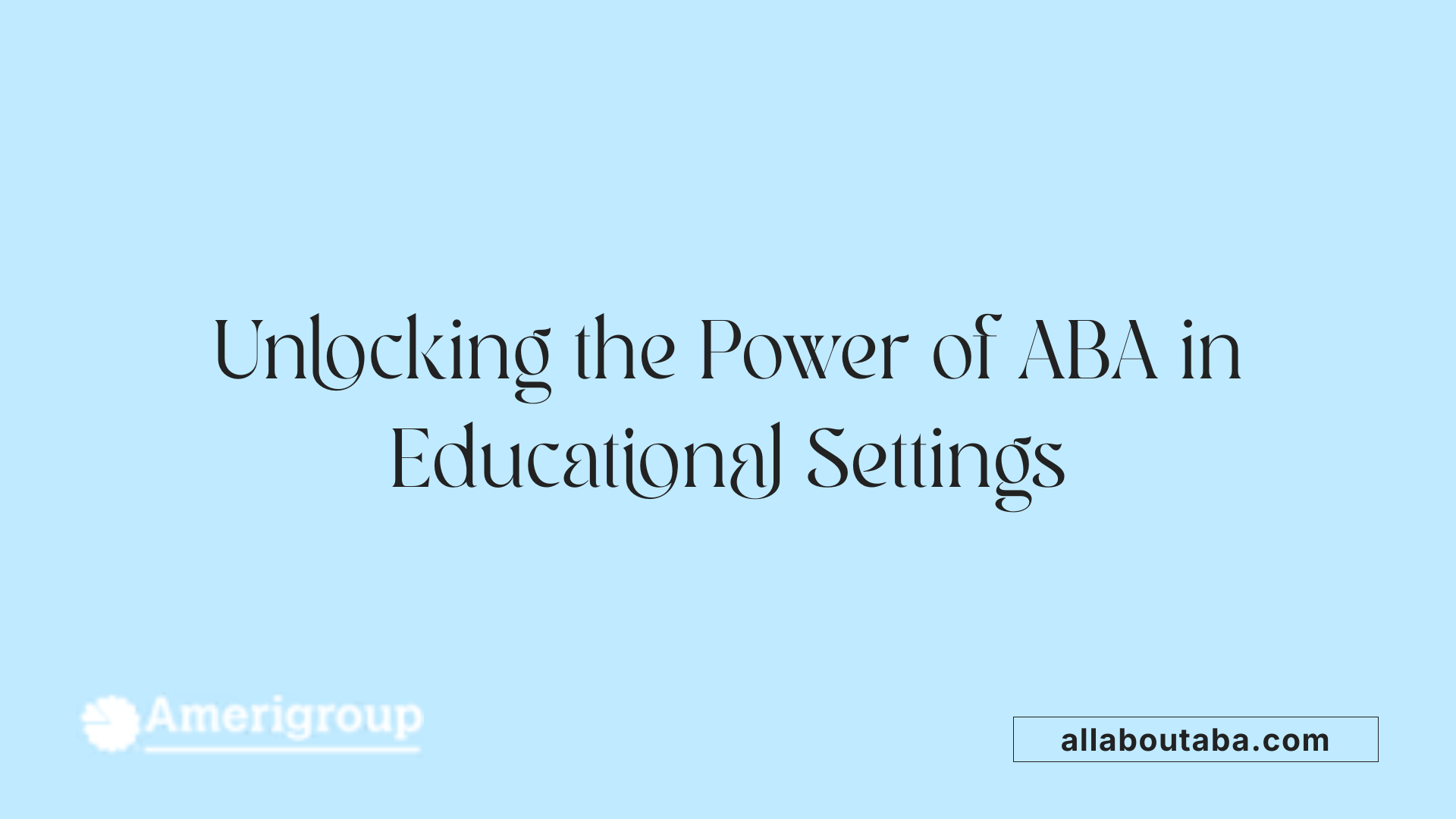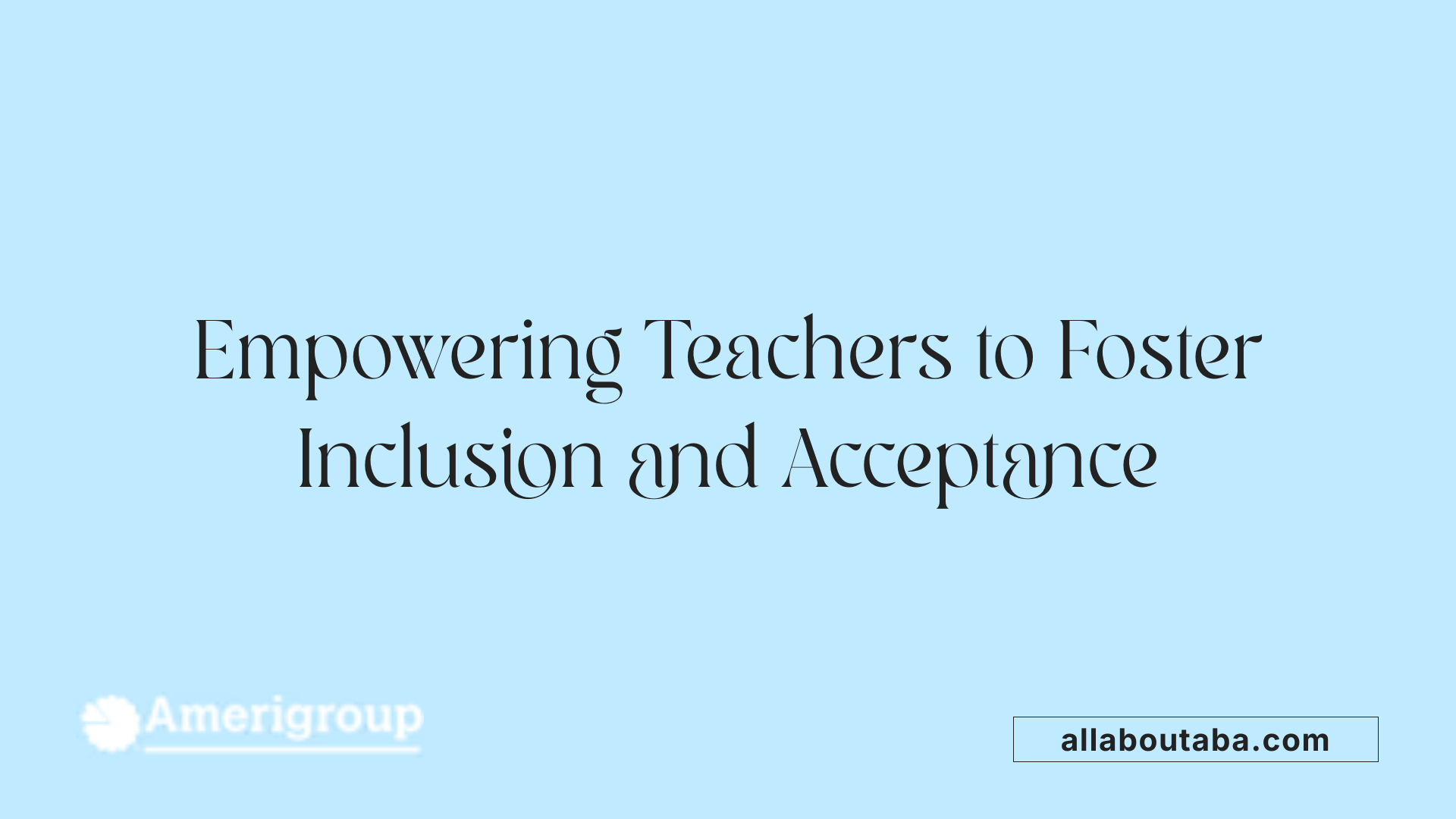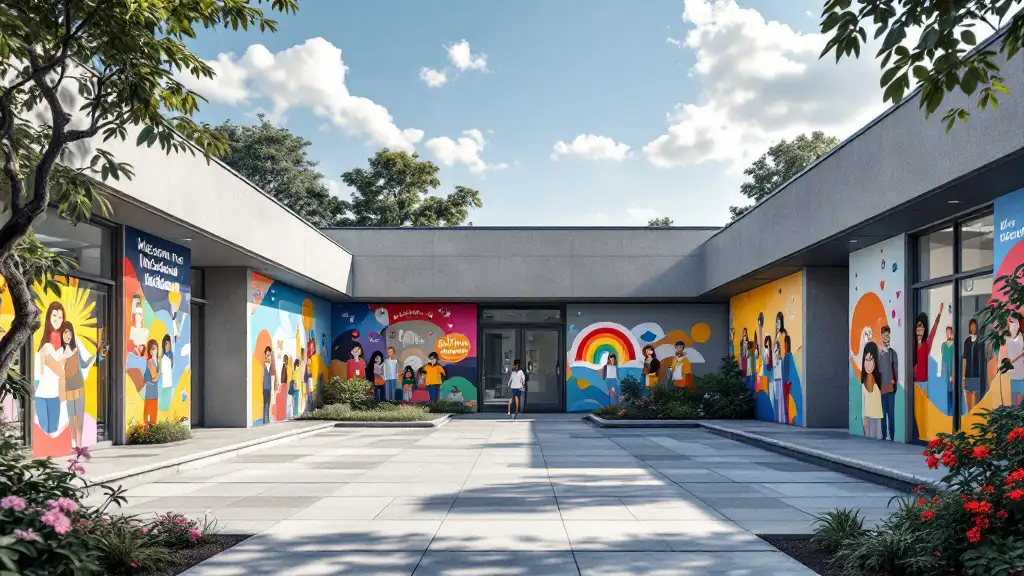The Role Of Teachers In Fostering Autism Peer Acceptance
Building Bridges: The Importance of Peer Acceptance in Autism
In inclusive educational environments, the role of teachers extends beyond academic instruction to fostering understanding and acceptance among all students. For children with autism, peer acceptance can profoundly impact social experiences, well-being, and developmental progress. This article explores how teachers can effectively cultivate autism peer acceptance through evidence-based programs and strategies that promote empathy, knowledge, and inclusive behaviors among neurotypical peers.
Understanding Applied Behavior Analysis (ABA) Therapy and Its Relevance to Education

What is Applied Behavior Analysis (ABA) therapy?
Applied Behavior Analysis (ABA) therapy is a scientifically backed approach used to help individuals, especially those with autism, develop essential skills and reduce challenging behaviors. It uses methods like positive reinforcement, prompting, and task analysis to encourage communication, social skills, and everyday functional abilities. ABA therapy is highly personalized, designed by Board Certified Behavior Analysts (BCBAs) to fit the unique needs and interests of each individual. Typically, this therapy involves intensive, long-term intervention, often spanning 20 to 40 hours per week, aiming for maximum developmental progress and greater independence.
Who provides ABA therapy for individuals with autism?
Qualified professionals such as BCBAs and trained therapists provide ABA therapy. These experts create and implement tailored programs to increase useful behaviors and reduce problematic ones. ABA therapy can be delivered in various settings like homes, schools, or community centers, depending on the individual's circumstances. Access to ABA services is often supported by insurance, regional centers, or school districts to ensure effective treatment for individuals with autism.
What are the benefits of ABA therapy for people with autism?
ABA therapy supports notable improvements in communication, social interaction, and daily living. Its personalized, evidence-based strategies foster skill development while reducing behaviors that interfere with learning or social inclusion. Early, intensive ABA intervention can empower children with autism to gain independence and engage more fully in mainstream environments. In addition, ABA helps enhance emotional regulation and social engagement, contributing significantly to improved quality of life.
What techniques are commonly used in ABA therapy?
ABA therapy employs diverse techniques such as positive reinforcement, prompting and fading, behavior chaining, and the ABC (Antecedent-Behavior-Consequence) approach. Visual aids like charts and videos support skill acquisition, while natural environment teaching helps generalize skills in everyday situations. Behavior assessments guide individualized interventions, enabling therapists to address each child’s unique challenges and strengths effectively.
How does ABA therapy differ from other autism therapies?
Unlike therapies that focus solely on communication or sensory regulation, ABA emphasizes modifying observable behaviors through data-driven reinforcement strategies. Modern ABA is flexible and play-based, encouraging enjoyment and generalization of skills rather than relying on repetitive drills. It also prioritizes ethical, positive approaches over outdated aversive methods. ABA’s distinct scientific foundation and focus on behavior modification make it complementary to other therapies, collectively supporting greater independence and social participation for individuals with autism.
The Reciprocal Effects Peer Interaction Model (REPIM) and Autism Peer Acceptance
What Is the Reciprocal Effects Peer Interaction Model (REPIM)?
The Reciprocal Effects Peer Interaction Model (REPIM) is a framework designed to improve social interactions between neurotypical children and their autistic peers. It operates on the idea that enhancing understanding and acceptance of autism within peer groups can reduce bullying and social exclusion. REPIM emphasizes mutual benefits: as neurotypical children learn more about autism, they develop empathy and positive attitudes, which in turn fosters better interactions and friendships.
How Does REPIM Promote Peer Acceptance?
At the core of REPIM is the promotion of reciprocal social interactions. The model encourages neurotypical children to engage with autistic peers by recognizing both similarities and differences, understanding sensory sensitivities, and appreciating individual strengths. Through these informed interactions, children build meaningful and inclusive relationships. This process not only supports autistic students but enriches the social experiences of all children involved.
Why Is Understanding Autism Crucial in Reducing Bullying?
Bullying and social exclusion often stem from misunderstandings and stereotypes. REPIM addresses this by providing education that expands knowledge about autism facts, sensory sensitivities, and behaviors. Increased understanding helps dismantle misconceptions, promoting respect and kindness. Consequently, classrooms become safer and more welcoming spaces where all students feel valued.
The Role of Peer Education in Schools
Peer education programs built on REPIM involve structured modules that inform children about autism and encourage inclusive behaviors. These programs typically cover topics such as autism characteristics, friendship skills, and recognizing the strengths of autistic individuals. Integrated into school curricula, such initiatives are effective in improving attitudes and behavioral intentions toward autistic peers. They are cost-effective, easy to implement, and have shown lasting positive effects on knowledge and acceptance even after one year.
These REPIM-based educational efforts foster environments where neurotypical children are empowered to support their autistic peers, contributing to overall inclusive and thriving school communities.
Design and Implementation of Effective Peer-Education Programs for Autism Acceptance

What Are the Key Components of Peer-Education Programs to Foster Autism Acceptance?
Peer-education programs aiming to promote autism acceptance are thoughtfully structured to facilitate understanding, acceptance, and inclusive behaviors among children. These programs usually consist of five weekly modules that cover essential topics such as facts about autism, similarities and differences among people, sensory sensitivities experienced by autistic individuals, their unique strengths, and friendship-building strategies.
Structure of Peer-Education Programs
The curriculum is designed to progressively develop knowledge and empathy, starting with basic facts and moving towards practical social skills. This approach helps children appreciate the diversity of their peers and equips them to engage positively.
Key Educational Modules Covered
- Autism Facts: Provides foundational knowledge to dispel myths.
- Similarities and Differences: Highlights commonalities alongside diversity.
- Sensory Sensitivities: Raises awareness about sensory experiences.
- Strengths of Individuals with Autism: Focuses on positive attributes.
- Friendship Building: Encourages inclusive social interactions.
Virtual and In-Person Delivery Approaches
The program has been successfully delivered via virtual platforms, demonstrating significant improvement in students' knowledge and attitudes toward autistic peers, with effects lasting over a year. To enhance reach and interaction, the program expanded to in-person presentations within third- and fourth-grade classrooms. This flexibility ensures the program can suit various learning environments.
Cost-Effectiveness and Scalability for Schools
Designed to be well-organized and easy to implement, these programs offer a cost-effective option for schools. Their adaptability and clear structure support sustainable integration into school curricula, fostering inclusive environments where both neurotypical and autistic children can thrive.
Measuring the Impact: Outcomes of Autism Peer Acceptance Programs

How effective are peer-education programs in improving knowledge and attitudes toward autistic peers?
Peer-education programs designed to enhance understanding and acceptance of autism have shown significant effectiveness. Using pretest, posttest, and follow-up evaluations, these programs have demonstrated that participating children gain substantial knowledge about autism. This improved understanding fosters more positive attitudes and greater acceptance toward their autistic peers.
What do sustained improvements in knowledge and attitudes reveal?
The sustained improvements observed through follow-up assessments, conducted up to a year after the program, highlight the long-term benefits of these initiatives. These enduring effects suggest the program’s curriculum—covering facts about autism, sensory sensitivities, shared similarities and differences, strengths, and friendship building—is successful in creating lasting change.
How do behavioral intentions translate into real-world effects?
Beyond changes in knowledge and attitudes, the program also positively influences children’s behavioral intentions toward peers with autism. These intentions foster inclusive actions and reduce social exclusion and bullying. Ultimately, this promotes a welcoming environment where neurotypical and autistic children can thrive together.
Why is long-term follow-up data important?
Long-term follow-up evaluations are crucial for assessing whether the benefits of peer-education programs persist over time. Maintaining gains in understanding and acceptance after one year provides evidence that such programs are impactful and not just temporary interventions. This data supports continued investment in scalable and cost-effective education models that nurture inclusion within classrooms.
| Aspect Evaluated | Findings | Significance |
|---|---|---|
| Knowledge of Autism | Increased from pretest to posttest | Builds foundation for empathy and inclusion |
| Attitudes toward Peers | More positive and accepting post-program | Reduces bullying and social exclusion |
| Behavioral Intentions | Improved willingness to include autistic peers | Encourages supportive peer interactions |
| Long-term Impact | Sustained effects after one year | Validates program’s lasting effectiveness |
The Crucial Role of Teachers in Facilitating Autism Peer Acceptance

What role do teachers play in fostering peer acceptance of students with autism?
Teachers serve as central facilitators in promoting peer acceptance for students with autism. They implement structured peer-education programs that enhance neurotypical students' understanding, acceptance, and empathy toward their autistic classmates. By leading activities and discussions based on models like the reciprocal effects peer interaction model (REPIM), teachers help reduce bullying and social exclusion.
Modeling inclusive behaviors
Beyond delivering educational content, teachers exemplify inclusive behaviors themselves. Their everyday actions and attitudes set a tone of respect and kindness in the classroom. By demonstrating how to accept differences and engage positively with all students, teachers encourage peers to emulate these inclusive social interactions.
Creating supportive classroom climates
Teachers nurture classroom environments where diversity is openly valued and all students feel safe and supported. These positive climates facilitate friendship building and promote ongoing acceptance of autistic peers. Teachers manage social dynamics and intervene when exclusion or misunderstanding arises to maintain this supportive atmosphere.
Collaboration with specialists and therapists
Effective inclusion often requires a team approach. Teachers work closely with specialists such as behavior analysts, speech therapists, and psychologists to tailor peer-education activities and behavioral supports. This collaboration ensures autistic students receive consistent messages of acceptance and that interventions are reinforced across settings.
Through their engagement in education, modeling, environment-building, and teamwork, teachers play a vital role in shaping norms that foster social inclusion and acceptance of students with autism in schools.
Bridging Therapy and Peer Interaction: Integrating ABA Techniques with Peer Education

How can principles of ABA therapy be integrated into peer-education programs to promote autism acceptance?
Applied Behavior Analysis (ABA) principles, such as positive reinforcement, prompting, and behavior chaining, provide a powerful framework for enhancing peer-education programs designed to promote understanding and acceptance of autistic children. When these techniques are incorporated into peer education, teachers and facilitators can encourage neurotypical students to demonstrate inclusive social behaviors through consistent positive feedback.
For example, during the five-week peer-education modules that address autism facts, sensory sensitivities, and friendship building, ABA strategies can be used to reinforce desirable behaviors like empathy, patience, and cooperative play. Prompting can gently guide children to respond respectfully to differences, while behavior chaining helps break down complex social interactions into smaller, manageable steps for skill development.
Enhancing social skills and behavioral intentions
The peer-education program's goal to improve children's knowledge and attitudes toward autistic peers aligns well with ABA's focus on observable behavioral change. By integrating ABA methods, educators can better influence not just attitudes but also the behavioral intentions of neurotypical children, encouraging real-world inclusive actions.
Complementing therapeutic interventions with classroom efforts
Crucially, this integration bridges clinical therapy with everyday social environments. Autism therapy often focuses on individual skill acquisition, while peer education nurtures an accepting and supportive community. Implementing ABA-informed peer education creates a well-organized, cost-effective, and easy-to-run model that supports autistic children's thriving in inclusive classrooms, maintaining positive outcomes over time as demonstrated by sustained effects after one year.
| Aspect | ABA Principle Applied | Impact on Peer Education |
|---|---|---|
| Positive Reinforcement | Rewarding inclusive behavior | Encourages ongoing acceptance and kindness |
| Prompting | Guiding social interaction | Helps students respond appropriately to autistic peers |
| Behavior Chaining | Breaking down social skills | Builds complex friendship skills step-by-step |
| Knowledge and Attitude Change | Informative peer-education modules | Facilitates understanding and reduces bullying |
| Sustainability | Cost-effective, classroom-based | Ensures long-term maintenance of positive social changes |
Advancing Inclusion Through Teacher Leadership
Teachers play an essential role in shaping inclusive educational environments that embrace neurodiversity. By implementing structured peer-education programs rooted in research-based models like REPIM and supported by principles of Applied Behavior Analysis, educators can empower neurotypical children to understand, accept, and engage positively with autistic peers. The sustained improvements in knowledge, attitudes, and behaviors demonstrated by such programs underscore their importance in reducing social exclusion and bullying. Moving forward, continued collaboration between teachers, therapists, and families will be vital to refine and expand these efforts, ultimately ensuring that all students thrive together in community.
References
- Promoting Autism Acceptance Through Peer Education
- Applied Behavior Analysis (ABA)
- Behavioral Health Treatment | Children with Autism Spectrum ...
- Access to ABA Therapy
- Applied Behavior Analysis (ABA)
- Applied Behavior Analysis (ABA)
- Applied Behavior Analysis
- What Is Applied Behavior Analysis (ABA)?
- ABA Techniques: Strategies for Behavior Analysts - GSEP Blog
- ABA Therapy Examples, Definition & Techniques
Other articles
Recent articles

The Role Of Teachers In Fostering Autism Peer Acceptance

Using Art Therapy To Support Children With Autism

Autism And Strategies For Addressing Sensory Defensiveness

Autism And The Benefits Of Structured Leisure Activities

How To Support Autistic Students During Exam Season

Autism And Goal Setting For Personal Growth

How To Use Gamification In Autism Learning Programs

How Schools Can Reduce Bullying Of Autistic Students

Early Intervention Strategies For Autism Spectrum Disorder

The Role Of Therapists In Autism Life Skills Coaching

How To Support Autistic Individuals In Crisis Situations

Autism And Self-Care Routines For Stress Management

Understanding Echolalia And Its Role In Autism Communication

Autism And Fine Arts Education Benefits

The Impact Of Multisensory Learning On Autism Education

How Family Counseling Supports Autism Household Dynamics

Best Practices For Inclusive Playgrounds For Autism

Best Practices For Autism-Friendly Shopping Centers

How Autism Affects Fine Motor Skill Development

Best Ways To Introduce Sensory Activities Into Daily Routines

How Sports Teams Can Be Inclusive Of Autistic Players

Autism And Strategies For Building Workplace Resilience

Autism And The Impact Of Hormonal Changes During Puberty

How To Support Autistic Students In Foreign Language Classes

Best Ways To Teach Money Skills To Teens With Autism

Supporting Siblings Of Children With Autism

Autism And Co-Occurring Gastrointestinal Disorders

The Role Of Art Projects In Autism Sensory Integration

How Schools Can Incorporate Sensory Break Spaces

Best Practices For Autism Sensory Regulation At School

Autism And Strategies For Teaching Organizational Skills

Understanding The Relationship Between Autism And Anxiety Disorders

Autism And Life Planning For Long-Term Care

Exploring Visual Supports In Autism Education

Ways To Encourage Social Interaction In Children With Autism

The Connection Between Autism And Dyscalculia

The Role Of Occupational Therapy In Transition Planning For Autism

The Role Of Physical Therapists In Autism Motor Skills Support

How To Teach Decision-Making Skills To Autistic Young Adults

The Connection Between Autism And Epilepsy

Best Practices For Transitioning Autistic Children Into New Schools

Autism And Time Management Challenges In Adulthood

The Role Of Visual Arts In Autism Communication Development

How To Address Tactile Defensiveness In Autism

Best Practices For Telehealth Autism Therapy

How To Help Autistic Children Develop Friendship Skills

How Schools Can Support Autistic Students In Career Prep

Best Strategies For Autism-Friendly Event Planning

Understanding Noncontingent Reinforcement In Autism Behavior Plans

How Drama Therapy Benefits Autistic Individuals

Best Practices For Autism-Friendly Fitness And Recreation Centers

Best Ways To Promote Healthy Social Media Use For Autistic Teens

How To Help Autistic Children Cope With Public Speaking

Autism And Strategies For Managing Unexpected Changes

Best Podcasts About Autism For Parents And Educators

Autism And The Impact Of Seasonal Changes On Behavior

The Role Of Diet In Managing Co-Occurring Conditions With Autism

Sleep Challenges In Autism And Practical Solutions

Best Ways To Build Daily Routines For Autistic Children

Best Practices For Supporting Autistic Entrepreneurs

Autism And Strategies For Navigating Large Social Gatherings

Adaptive Sports And Recreational Activities For People With Autism

Autism And The Benefits Of Story-Based Learning Activities

Understanding The Role Of Play In Autism Development

Autism And The Impact Of Environmental Noise On Learning

How To Create Autism-Friendly Community Spaces

Autism And Chronic Health Conditions: What To Know

The Role Of Care Managers In Autism Life Planning

How To Teach Social Boundaries To Autistic Children

How Autistic Individuals Experience Empathy Differently

How To Support Autistic Employees In Remote Work Settings

Autism And The Relationship Between Motor Skills And Learning

How To Create Community Resource Guides For Autism Families

How To Teach Daily Living Skills To Autistic Teens

Autism And The Impact Of Mind-Body Practices On Stress Reduction

Autism And The Benefits Of Outdoor Group Activities

How To Create Autism-Friendly Sensory Paths In Schools

Best Practices For Autism-Friendly Park And Recreation Areas

Autism And Strategies For Reducing School Refusal

Supporting Autistic Individuals In Public Speaking

The Role Of Diet In Managing Autism Symptoms

The Benefits Of Gardening Clubs For Autism Social Development

How To Prepare Autistic Children For Dental Visits

Autism And Employment: Career Paths That Work

Best Practices For Autism-Friendly Hotels And Lodging

The Impact Of Screen Time On Autism Development

Autism Screening Tools For Early Childhood

The Role Of Physical Exercise In Autism Therapy

Best Strategies For Supporting Autistic College Students

The Role Of Technology In Autism Early Detection

Sensory-Friendly Classroom Design Ideas For Autistic Students

The Role Of Speech Therapy In Building Social Communication Skills

Best Strategies For Handling Autistic Burnout In Adults

Autism And The Importance Of Predictability In Routine

Autism And Peer Education: Teaching Acceptance In Schools

Best Practices For Sensory-Friendly Libraries And Reading Rooms

Self-Advocacy Skills For Autistic Adults

The Role Of Technology In Autism Peer Communication

Promoting Physical Activity In Children With Autism

How To Prepare Autistic Children For Medical Procedures
We’re All About You, Your Family, and Your Child

